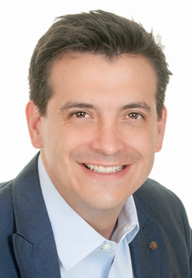


Great materials for the implant abutments and the restorations has been developed and improved in the last decade. Many of these materials have outstanding powerful properties both mechanically and visually with solid scientific evidence. However it has been difficult for the restorative dentist to keep up with the overwhelming amount of new ceramic material options and their indications. Our responsibility is to know precisely when and how to use these great mateials. The goal of this presentation is to show an algorithm to make the best evidence based clinical choice when selecting materials for the implant abutment and the restorations.
Patients' requests and clinicians' interest in esthetic restorations are not limited to anterior teeth. As a result, posterior "tooth-colored" adhesive restorative techniques considerably grew over the last decade and a plethora of materials and methods are available to the clinician today. The survival rates of adhesive restorations in posterior teeth appears to be quite satisfying, even placed by dental students, to the point that some countries today have abandoned the teaching of amalgam restorations and other traditional metallic restorations. Apart from their cosmetic advantage, the new adhesive techniques offer many other benefits such as tissue conservation and natural strengthening of remaining tooth substance. These emerging concepts, which are following the so-called "biomimetic approach", provide the ability to restore not only the esthetic but also the biomechanical and structural integrity of teeth. This presentation will show that dental composites and ceramics constitute striking elements of this nascent approach to tooth restoration. Indications for bonded restorations in the posterior dentition will be presented, including the biomimetic approach to severe loss of coronal substance and nonvital teeth. Attendants should benefit from these considerable improvements that should influence both the medicobiological and socioeconomical approaches of their practice: more sound tissue preservation, maintenance of tooth vitality, less expensive procedures compared to traditional and more invasive "prosthodontics".
Ultraconservative Esthetic Treatment Options (1/2 day)
This course will address the indications and considerations for orthodontic extrusion and other complex orthodontic movements in the esthetic zone in preparation for implant rehabilitation avoiding undesirable periodontal amputation that occurs following tooth loss. Participants will learn the proper treatment sequence and step-by-step technique.
About the Speaker
Dr. Marco Brindis is the Chairman of the Prosthodontics Department of Louisiana State University, where he also maintains an intramural restorative practice devoted to esthetics and implants with an interdisciplinary approach. He earned a D.D.S from the Universidad Intercontinental in Mexico City in 1998. He did a Preceptorship in Dental Implants at the Universidad Intercontinental in 1999 and a Preceptorship in Dental Implants at the Dental School at the UT Health Science Center in San Antonio in 2002. He completed a surgical Implant Fellowship at the Biotechnology Institute in Vitoria Spain in 2003. He got his Certificate in Prosthodontics at LSU School of Dentistry in the Department of Prosthodontics in 2007. He then completed all the Esthetic and Occlusion courses at the Pankey Institute in 2007. Dr. Brindis is very passionate in the field of interdisciplinary dentistry for full mouth reconstruction, esthetics and implant dentistry. Also he is involved in the development of new implant protocols to treat the edentulous patient. He has lectured in the United States, Mexico, Canada and Spain. He is member of several organizations including the Academy of Osseointegration, American Dental Association, American College of Prosthodontist and the Pierre Fauchard Academy.